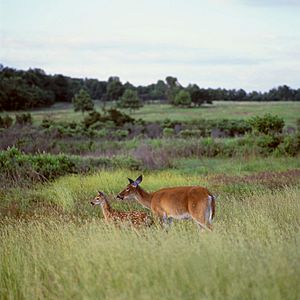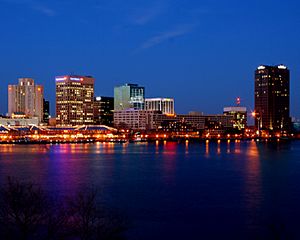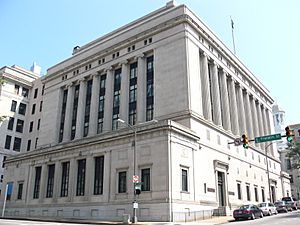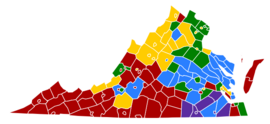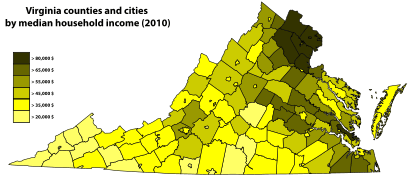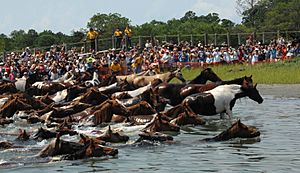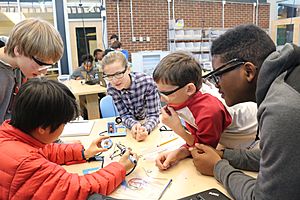Virginia facts for kids
Quick facts for kids
Virginia
|
|||
|---|---|---|---|
| Commonwealth of Virginia | |||
|
|||
| Nicknames:
Old Dominion, Mother of Presidents
|
|||
| Motto(s): | |||
| Anthem: "Our Great Virginia" | |||
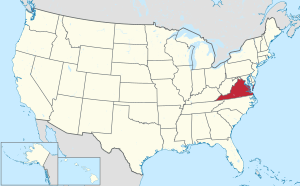
Location of Virginia within the United States
|
|||
| Country | United States | ||
| Before statehood | Colony of Virginia | ||
| Admitted to the Union | June 25, 1788 (10th) | ||
| Capital | Richmond | ||
| Largest city | Virginia Beach | ||
| Largest county or equivalent | Fairfax | ||
| Largest metro and urban areas | Washington (metro and urban) | ||
| Legislature | General Assembly | ||
| • Upper house | Senate | ||
| • Lower house | House of Delegates | ||
| Judiciary | Supreme Court of Virginia | ||
| U.S. senators |
|
||
| U.S. House delegation | 6 Democrats 5 Republicans (list) |
||
| Area | |||
| • Total | 42,774.2 sq mi (110,785.67 km2) | ||
| Area rank | 35th | ||
| Dimensions | |||
| • Length | 430 mi (690 km) | ||
| • Width | 200 mi (320 km) | ||
| Elevation | 950 ft (290 m) | ||
| Highest elevation | 5,729 ft (1,746 m) | ||
| Lowest elevation | 0 ft (0 m) | ||
| Population
(2024)
|
|||
| • Total | |||
| • Rank | 12th | ||
| • Density | 219.3/sq mi (84.7/km2) | ||
| • Density rank | 14th | ||
| • Median household income | $89,900 (2023) | ||
| • Income rank | 10th | ||
| Demonym(s) | Virginian | ||
| Language | |||
| • Official language | English | ||
| • Spoken language |
|
||
| Time zone | UTC−05:00 (Eastern) | ||
| • Summer (DST) | UTC−04:00 (EDT) | ||
| USPS abbreviation |
VA
|
||
| ISO 3166 code | US-VA | ||
| Traditional abbreviation | Va. | ||
| Latitude | 36° 32′ N to 39° 28′ N | ||
| Longitude | 75° 15′ W to 83° 41′ W | ||
Virginia, officially the Commonwealth of Virginia, is a state in the Mid-Atlantic and Southeastern parts of the United States. It lies between the Atlantic Coast and the Appalachian Mountains. The state's land and weather are shaped by the Blue Ridge Mountains and the Chesapeake Bay. These features create homes for many plants and animals.
The capital of Virginia is Richmond. Virginia Beach is the city with the most people. Fairfax County is the most populated area. In 2020, Virginia had over 8.65 million people. About 36% of them lived near the Baltimore–Washington metropolitan area.
Virginia's story began with many indigenous groups, like the Powhatan. In 1607, the London Company started the Colony of Virginia. This was the first lasting English colony in the New World. Virginia's nickname, "Old Dominion," comes from this important start. Over time, the use of enslaved labor and land taken from native tribes helped the economy grow. But this also led to conflicts.
Virginia was one of the original Thirteen Colonies. It became part of the United States in 1776 during the American Revolution. During the American Civil War, Virginia split. The government in Richmond joined the Confederacy. But many counties in the northwest wanted to stay with the Union. This led to the creation of West Virginia in 1863.
Virginia's state legislature is the Virginia General Assembly. It started in July 1619. This makes it the oldest law-making body still active in North America. It has a 40-member Senate and a 100-member House of Delegates. Virginia's economy includes farming in the Shenandoah Valley. It also has high-tech companies and government offices in Northern Virginia. These include the main offices for the U.S. Department of Defense and the Central Intelligence Agency. Military bases are found in Hampton Roads, which is also home to the region's main seaport.
Contents
- Discover Virginia's Geography
- Virginia's Rich History
- Virginia's Cities and Towns
- Virginia's Government System
- Virginia's People and Culture
- Virginia's Economy and Jobs
- Virginia's Culture and Traditions
- Getting Around Virginia: Transportation
- Virginia's State Symbols
- Sports in Virginia
- Learning in Virginia: Education
- Images for kids
- See also
Discover Virginia's Geography
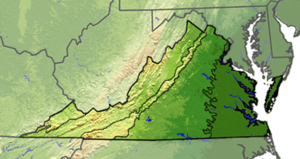
Virginia covers about 42,774 square miles (110,786 square kilometers). This makes it the 35th largest state by area. About 3,180 square miles (8,236 square kilometers) of this is water. Virginia shares borders with Maryland and Washington, D.C. to the north and east. The Atlantic Ocean is to its east. North Carolina is to the south. Tennessee is to the southwest. Kentucky is to the west. And West Virginia is to the north and west.
Virginia's Land and Mountains
The Chesapeake Bay separates the main part of Virginia from its two-county peninsula, the Eastern Shore. The bay was formed from old river valleys. Many of Virginia's rivers flow into the Chesapeake Bay. These include the Potomac, Rappahannock, York, and James rivers. They create three peninsulas in the bay.

The Tidewater is a flat coastal area between the Atlantic coast and the fall line. It includes the Eastern Shore and the large river mouths of Chesapeake Bay. The Piedmont is a series of rolling hills east of the mountains. This region is known for its heavy clay soil. The Blue Ridge Mountains are the highest points in the state. Mount Rogers is the tallest at 5,729 feet (1,746 meters). West of the Blue Ridge Mountains is the Ridge and Valley region. The Cumberland Plateau is in the southwest corner of Virginia.
Virginia does not have many strong earthquakes. This is because it is far from the edges of the North American Plate. The largest earthquake was in 1897 near Blacksburg. It was about 5.9 in strength. A 5.8 earthquake hit central Virginia in 2011 near Mineral. People felt it as far away as Toronto and Florida.
Coal mining happens in the three mountainous regions. Virginia also mines other resources like slate and sand. The state has over 4,000 caves, and ten of them are open for visitors. Millions of years ago, a large space rock hit eastern Virginia. The crater it made might explain why some areas are sinking.
Virginia's Climate and Weather
Virginia's climate is temperate. It gets warmer and more humid the farther south and east you go. Winter lows average 26°F (-3°C) in January. Summer highs average 86°F (30°C) in July. The Atlantic Ocean affects the eastern coastal areas. These areas can experience hurricanes, especially near the Chesapeake Bay.
Virginia has thunderstorms about 35–45 days a year. The western part of the state sees more of them. The average yearly rainfall is 42.7 inches (108.5 cm). Cold air in winter can bring heavy snowfalls. Virginia has about seven tornadoes each year. Most are not very strong.
In recent years, cities like Washington, D.C. have grown. This has led to an urban heat island effect in Northern Virginia. This means cities get hotter because buildings and roads absorb more sunlight.
Virginia's Ecosystem: Plants and Animals
Forests cover 65% of Virginia. Most trees in the west are deciduous, meaning they lose their leaves. Evergreens are more common in central and eastern Virginia. Lower areas have dense groups of hemlocks and mosses. Oak and hickory trees grow in the Blue Ridge. In the lowlands, yellow pines are common. Bald cypress trees grow in swamps. Other common plants include red bay, wax myrtle, and many types of ferns. The largest wild areas are along the Atlantic coast and in the western mountains. Here, you can find many trillium wildflowers.
Virginia is home to many mammals. These include white-tailed deer, black bear, beaver, bobcat, coyote, raccoon, and skunk. Birds like cardinals (the state bird), bald eagles, and wild turkeys live here. The peregrine falcon was brought back to Shenandoah National Park in the 1990s. Virginia has 210 types of freshwater fish, like walleye and brook trout. The Chesapeake Bay has many creatures, including blue crabs, clams, and oysters.
Virginia has 30 National Park Service sites. These include Great Falls Park and the Appalachian Trail. Shenandoah National Park was created in 1935. It has the beautiful Skyline Drive. Almost 40% of the park is protected wilderness. There are also 34 Virginia state parks and 17 state forests. The Chesapeake Bay is protected by state and federal laws. The Great Dismal Swamp National Wildlife Refuge is also in Virginia.
Virginia's Rich History
In 2007, Virginia celebrated 400 years since the Jamestown Colony was founded. This event, called "Jamestown 2007," honored the contributions of Native Americans, Africans, and Europeans. All of them helped shape Virginia's history. Wars have also played a big part. Virginia was central to conflicts like the French and Indian War, the American Revolution, and the Civil War. Famous figures like Pocahontas, John Smith, and George Washington are part of Virginia's past.
The Colony of Virginia
The first people arrived in Virginia over 12,000 years ago. By 5,000 years ago, people started to settle down. Farming began around 900 AD. By 1500, the Algonquian peoples had towns like Werowocomoco. They called their land Tsenacommacah. Other language groups were the Siouan to the west and the Iroquoians to the north and south. By 1607, about 13,000 to 14,000 native people lived in the Tidewater area.
Europeans explored the Chesapeake Bay in the 1500s. In 1583, Queen Elizabeth I allowed Walter Raleigh to start a colony. The name "Virginia" might have come from Raleigh or Elizabeth, who was called the "Virgin Queen." The London Company started the first lasting English settlement in the "New World" at Jamestown in May 1607. It was named after King James I. In 1619, colonists gained more control with an elected group called the House of Burgesses.
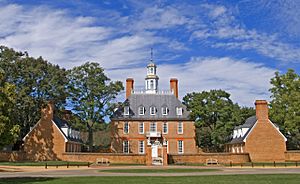
Life in the colony was hard. Many died during the Starving Time in 1609. Conflicts with native tribes also caused many deaths. By 1624, only 3,400 of the first 6,000 settlers were still alive. However, Europe's demand for tobacco brought more settlers. African workers first arrived in Jamestown in 1619. Over time, a system of slavery developed. By 1662, a law made slavery hereditary, meaning children of enslaved mothers were also enslaved.
Tensions between workers and the ruling class led to Bacon's Rebellion in 1676. This rebellion also opposed the policy toward native tribes. One result was the Treaty of 1677, which made some tribes dependent on the colony. In 1693, The College of William & Mary was founded at Middle Plantation. This place was renamed Williamsburg and became the colonial capital in 1699. In 1747, a group formed the Ohio Company to settle lands west of the Appalachian Mountains. This led to the French and Indian War with France. George Washington led a militia from British colonies during this war.
Becoming a State

The British Parliament tried to add new taxes after the French and Indian War. This made colonists very unhappy. In the House of Burgesses, Patrick Henry and Richard Henry Lee led the fight against "taxation without representation". Virginians started working with other colonies in 1773. They sent delegates to the Continental Congress.
On May 15, 1776, Virginia declared its independence from the British Empire. It adopted George Mason's Virginia Declaration of Rights. Another Virginian, Thomas Jefferson, used Mason's ideas to write the Declaration of Independence.
When the American Revolutionary War began, George Washington was chosen to lead the colonial army. During the war, the capital moved to Richmond. This was because Governor Thomas Jefferson worried Williamsburg was too close to the coast. In 1781, American and French forces trapped the British army on the Virginia Peninsula. George Washington and Comte de Rochambeau defeated British General Cornwallis at the Siege of Yorktown. This surrender led to peace talks and secured the colonies' independence.
Virginians helped write the United States Constitution. James Madison wrote the Virginia Plan in 1787 and the Bill of Rights in 1789. Virginia approved the Constitution on June 25, 1788. Virginia is called "Mother of States." This is because many new states, like Kentucky in 1792, were formed from its territory. Also, many American pioneers were born in Virginia.
Civil War and Its Aftermath
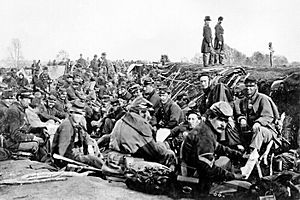
By 1860, about 31% of Virginia's population, nearly half a million people, were enslaved. This issue helped cause the American Civil War.
Virginia voted to leave the United States on April 17, 1861. On April 24, Virginia joined the Confederate States of America. Richmond became its capital. However, 48 counties in the northwest formed West Virginia in 1863. They chose to stay with the Union. Virginian general Robert E. Lee led the Army of Northern Virginia. More battles were fought in Virginia than anywhere else. These included Bull Run and the Battle of Appomattox Court House. After Richmond was captured in April 1865, Virginia was formally back in the United States in 1870.
After the war, during the Reconstruction era, Virginia adopted a new constitution. It created free public schools and gave voting rights to more people. However, the conservative white Democratic Party later passed Jim Crow laws. These laws created segregation and made it harder for African Americans and poor white people to vote. Despite this, African Americans worked together to build their communities.
Virginia in Modern Times

New industries changed Virginia. In 1880, James Albert Bonsack invented a machine to roll cigarettes. This led to large-scale tobacco production in Richmond. In 1886, Collis Potter Huntington started Newport News Shipbuilding. This company built many ships for the U.S. Navy. In 1926, John D. Rockefeller, Jr. helped restore colonial buildings in Williamsburg. This project, called Colonial Williamsburg, became a major tourist spot.

In 1951, protests against segregated schools in Farmville led to a lawsuit. This case, Davis v. County School Board of Prince Edward County, was part of the Brown v. Board of Education decision in 1954. This decision said that "separate but equal" schools were not fair. However, Virginia resisted this change.
The Civil Rights Movement grew in the 1960s. This led to national laws like the Civil Rights Act of 1964 and the Voting Rights Act of 1965. In 1967, the Supreme Court ended Virginia's ban on marriages between different races. From 1969 to 1971, state lawmakers updated the constitution. In 1989, Douglas Wilder became the first African American governor in the United States.
The Cold War led to more government offices in Northern Virginia. These included the Central Intelligence Agency in Langley and the Pentagon. The Pentagon was attacked on September 11, 2001.
Virginia's Cities and Towns
Virginia has 95 counties and 38 independent cities. These cities act like counties in many ways.
Fairfax County has over one million people. It is the most populated area in Virginia. Neighboring Prince William County is the second most populated. It is home to Marine Corps Base Quantico and the FBI Academy.
Virginia's Largest Cities
- Virginia Beach - population 448,479
- Norfolk - population 246,139
- Chesapeake - population 230,571
- Arlington - population 224,906
- Richmond - population 214,114
- Newport News - population 182,020
- Alexandria - population 148,892
- Hampton - population 136,699
- Roanoke - population 98,465
- Portsmouth - population 96,205
Virginia's Government System
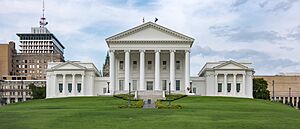
The first Virginia General Assembly met in 1619. This makes Virginia's legislature the oldest in North America. Today, the government follows the seventh Constitution of Virginia, approved in 1970. It has three parts: a legislature, an executive, and a judicial system.
Virginia's legislature has two parts: a 100-member House of Delegates and a 40-member Senate. They work together to make laws. Delegates serve two-year terms, and senators serve four-year terms. The executive branch includes the governor, lieutenant governor, and attorney general. They are elected every four years. Governors cannot serve two terms in a row. The lieutenant governor leads the Senate.
The legislature meets every year. They meet for up to 48 days in election years and 60 days in other years. Special meetings can be called by the governor or by two-thirds of both houses.
Virginia's Legal System
Judges and justices in Virginia's court system are chosen by the House and Senate. The judicial system is also the oldest in America. The court system starts with local courts. Above them are the Circuit Courts. Then comes the Court of Appeals of Virginia. At the top is the Supreme Court of Virginia. It has seven justices who serve 12-year terms. They must retire at age 73.
The Code of Virginia contains all the state's laws. The largest law enforcement agency is the Virginia State Police. The Virginia Marine Police protect the state's waters. The Virginia Capitol Police protect the government buildings. The governor can also call on the Virginia National Guard.
Virginia's People and Culture
| Historical population | |||
|---|---|---|---|
| Census | Pop. | %± | |
| 1790 | 691,737 | — | |
| 1800 | 807,557 | 16.7% | |
| 1810 | 877,683 | 8.7% | |
| 1820 | 938,261 | 6.9% | |
| 1830 | 1,044,054 | 11.3% | |
| 1840 | 1,025,227 | −1.8% | |
| 1850 | 1,119,348 | 9.2% | |
| 1860 | 1,219,630 | 9.0% | |
| 1870 | 1,225,163 | 0.5% | |
| 1880 | 1,512,565 | 23.5% | |
| 1890 | 1,655,980 | 9.5% | |
| 1900 | 1,854,184 | 12.0% | |
| 1910 | 2,061,612 | 11.2% | |
| 1920 | 2,309,187 | 12.0% | |
| 1930 | 2,421,851 | 4.9% | |
| 1940 | 2,677,773 | 10.6% | |
| 1950 | 3,318,680 | 23.9% | |
| 1960 | 3,966,949 | 19.5% | |
| 1970 | 4,648,494 | 17.2% | |
| 1980 | 5,346,818 | 15.0% | |
| 1990 | 6,187,358 | 15.7% | |
| 2000 | 7,078,515 | 14.4% | |
| 2010 | 8,001,024 | 13.0% | |
| 2020 | 8,631,393 | 7.9% | |
| 2024 (est.) | 8,811,195 | 10.1% | |
| 1790–2020, 2024 | |||
The 2020 census found Virginia's population was 8,631,393. This was a 7.9% increase since 2010. Virginia has the fourth-largest overseas population among U.S. states. This is due to federal employees and military members. The average age in Virginia is 38.8 years old.
Virginia has seen more people leave than move in since 2013. This is partly because of high home prices in Northern Virginia. Many residents move south to places like Raleigh. About 12% of Virginia residents were born outside the United States in 2020. El Salvador is the most common country of birth for these residents.
Virginia's Diverse Population
The largest group in Virginia is non-Hispanic whites. Their share of the population has decreased from 76% in 1990 to 58.6% in 2020. Many early immigrants came from Britain and Ireland. The Appalachian mountains have many settlements started by German and Scotch-Irish immigrants. Over 10% of Virginians have German ancestors.

The largest minority group is Black and African Americans, making up about one-fifth of the population. Virginia was a major destination for the Atlantic slave trade. The Igbo people from what is now southern Nigeria were the largest African group among enslaved people in Virginia. Many Black Virginians also have European or Native American ancestors. After 1965, many Black people started returning south to Virginia. Virginia has the highest number of marriages between Black and white people in the U.S. About 8.2% of Virginians say they are multiracial.
More recent immigrants have created new Hispanic and Asian communities. In 2020, 10.5% of Virginians were Hispanic or Latino. And 8.8% were Asian. The Hispanic population grew by 92% from 2000 to 2010. Two-thirds of Hispanics in the state live in Northern Virginia. Northern Virginia also has many Vietnamese Americans and Korean Americans. About 45,000 Filipino Americans live in the Hampton Roads area.
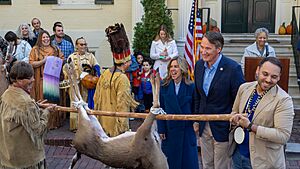
In 2020, the U.S. Census Bureau found that 0.5% of Virginians were only American Indian or Alaska Native. However, 2.1% were a mix with other groups. The state government recognizes eleven tribes. Seven tribes also have federal recognition. The Pamunkey and Mattaponi tribes have reservations on rivers that flow into the York River.
| Largest race by county or city | Race and ethnicity (2020) | Alone | Total | |||
|---|---|---|---|---|---|---|

|
Non-Hispanic White | 58.6% | 62.8% | |||
| Black or African American | 18.3% | 20.1% | ||||
| Hispanic or Latino (of any race) | 10.5% | |||||
| Asian | 7.1% | 8.6% | ||||
| American Indian and Alaska Native | 0.2% | 1.5% | ||||
| Other | 0.6% | 1.5% | ||||
| Largest ancestry by county or city | Ancestry (2020 est.) | Total | ||||
| Irish or Scotch-Irish | 10.4% | |||||
| German | 10.3% | |||||
| English | 9.8% | |||||
| American | 9.4% | |||||
| Subsaharan African | 2.3% | |||||
Languages Spoken in Virginia
In 2010, about 85.9% of Virginians aged five and older spoke English at home. About 14.1% spoke other languages. Spanish was the most common other language, spoken by 6.4% of residents. English became the official language of Virginia in 1981 and again in 1996.
The Piedmont region is known for its strong influence on Southern American English. In cities, a more common American English is heard. But different accents still exist, like the Tidewater accent.
Religion in Virginia
| Religious groups (2014 est.) | ||||
|---|---|---|---|---|
| Protestant | 58% | |||
| Unaffiliated | 20% | |||
| Catholic | 12% | |||
| Mormon | 2% | |||
| Eastern Orthodox | 1% | |||
| Other faith | 6% | |||
Virginia is mostly Christian and Protestant. Baptist churches make up the largest group, with over a quarter of the population in 2014. Roman Catholics are the next largest group, at about 12%. The United Methodist Church makes up about 6% of Virginians.
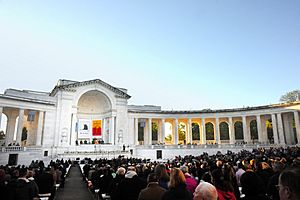
Other religions are also present. The Church of Jesus Christ of Latter-day Saints makes up 1% of the population. There are also Buddhist, Hindu, and Muslim communities. The All Dulles Area Muslim Society in Sterling is one of the largest Muslim communities in the country. Jewish sites in Virginia date back to 1789. Many Christian universities are in the state, like Regent University and Liberty University.
Virginia's Economy and Jobs
Virginia's economy gets money from many places. These include local and federal government, military, farming, and high-tech industries. In 2018, the state's average earnings per job were $63,281. This was the 11th highest in the nation. The state's total economic output was $476.4 billion in 2018.
Virginia's median household income was $72,600 in 2018. This was the 11th highest nationwide. The poverty rate was 10.7%, which was the 12th lowest. Loudoun County has the highest median household income in the nation. The wider Northern Virginia area is one of the richest regions in the country.
Virginia is known as a good place for business. In 2021, CNBC named Virginia the "Top State for Business." Forbes magazine ranked it fourth overall. Virginia has been a "right to work" state since 1947. This means workers cannot be forced to join a union. The minimum wage was raised to $9.50 an hour in April 2021. It is planned to increase to $12 in 2023.
Businesses in Virginia
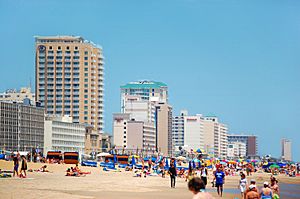
In 2012, Virginia had 653,193 businesses. About 54% were owned by men, and 36.2% by women. About 28.3% were owned by minorities, and 11.7% by veterans. Twenty-one Fortune 500 companies have their main offices in Virginia. Some of the largest by money earned are Freddie Mac and General Dynamics. The largest by number of employees are Dollar Tree and Hilton Worldwide Holdings.
Virginia has the third highest number of technology workers in the U.S. in 2020. These 451,268 tech jobs make up 11.1% of all jobs in the state. Many of these jobs are in Northern Virginia. This area has many software, communication, and cybersecurity companies. Amazon chose Crystal City for its second headquarters in 2018. Google also expanded its offices in Reston in 2019. Virginia became the world's largest data center market in 2016.
Tourism is Virginia's fifth largest industry. It supported about 234,000 jobs in 2018. It brought in $26 billion. Arlington County is the top tourist spot in the state. Virginia also welcomed 1.1 million international tourists in 2018.
Virginia's Agriculture and Farming
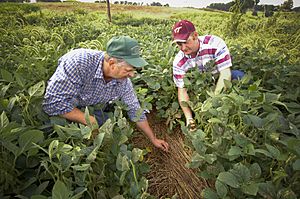
In 2017, farming used 28% of Virginia's land. This was about 7.8 million acres (31,565 square kilometers). Nearly 54,000 Virginians work on the state's 43,225 farms. Farming is still the largest single industry in Virginia. It provides over 334,000 jobs. Soybeans were the most profitable crop in 2017. Virginia is also the third-largest producer of tobacco in the United States.
Virginia is the country's third-largest producer of seafood. This includes sea scallops, oysters, and Chesapeake blue crabs. Commercial fishing supports over 18,000 jobs. Oyster harvests have grown a lot. Virginia also has many wineries. It has the seventh-highest number of wineries in the nation, with 307 in 2020. Cabernet franc and Chardonnay are the most common grapes grown.
Taxes in Virginia
Virginia collects personal income tax. There are five tax rates, from 2.0% to 5.75% of taxable income. The state sales tax rate is 4.3%. There is also a 1% local tax, making it 5.3% total. In some areas like Northern Virginia, the sales tax is higher. Virginia collects sales tax on groceries, but at a lower rate of 2.5%.
Property tax is set and collected by local governments. It varies across the state. In 2018, the average real estate tax rate was $1.07 per $100 of value for cities. About 61% of local government tax money comes from real property taxes.
Virginia's Culture and Traditions
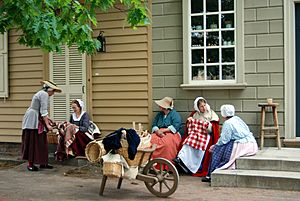
Virginia's culture became popular across America. Figures like George Washington and Thomas Jefferson helped spread it. Their homes in Virginia are seen as the birthplace of America. Modern Virginia culture is part of the culture of the Southern United States. The Smithsonian Institution divides Virginia into nine cultural regions.
Virginia has its own special food traditions. Virginia wine is made in many parts of the state. Smithfield ham is a type of country ham protected by state law. It can only be made in Smithfield. Virginia's furniture and buildings are typical of American colonial architecture. Thomas Jefferson liked the Neoclassical architecture style.
Literature in Virginia often talks about the state's long history. Writers like Ellen Glasgow and William Styron explored social issues and history. Mount Vernon native Matt Bondurant wrote about moonshiners during prohibition. Virginia also has a state Poet Laureate.
Festivals and Celebrations
Many counties and towns have fairs and festivals. The Virginia State Fair is held every September. Also in September is the Neptune Festival in Virginia Beach. It celebrates the city and local artists. Norfolk's Harborfest in June has boat races and air shows. Fairfax County hosts Celebrate Fairfax! with music. The Virginia Lake Festival is in July in Clarksville.
On the Eastern Shore island of Chincoteague, the annual Pony Swim & Auction is a special tradition. It happens at the end of July. The Shenandoah Apple Blossom Festival is a six-day festival in Winchester. It has parades and bluegrass concerts. The Old Time Fiddlers' Convention in Galax is one of the oldest and largest in the world. Virginia also has important film festivals in Charlottesville and Richmond.
Getting Around Virginia: Transportation
The state government controls most of Virginia's roads. This is different from most other states. In 2018, the Virginia Department of Transportation (VDOT) managed over 57,867 miles (93,128 kilometers) of roads. This makes it the third largest state highway system in the U.S. Traffic on Virginia's roads can be very bad. The average commute time is 28.7 minutes. This is the eighth longest in the U.S. The Washington Metropolitan Area, including Northern Virginia, has the second worst traffic.
About 4.4% of Virginians use public transit to get to work. In 2019, there were over 171.9 million public transit trips. More than 62% of these were on the Washington Metro system. This system serves Arlington and Alexandria. Virginia has Amtrak passenger train service. Virginia Railway Express (VRE) has two commuter lines into Washington, D.C. Major freight railroads include Norfolk Southern and CSX Transportation. VDOT also runs several free ferries, like the Jamestown Ferry.
Virginia has five major airports. These are Washington Dulles International and Reagan Washington National in Northern Virginia. They handle over 20 million passengers a year. Other airports include Richmond International and Norfolk International. The Virginia Port Authority's main seaports are in Hampton Roads. They moved over 60 million short tons (54 million metric tons) of cargo in 2019. The Eastern Shore of Virginia is home to Wallops Flight Facility, a rocket launch center.
Virginia's State Symbols
|
|
Sports in Virginia
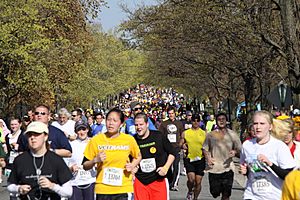
Virginia is the largest U.S. state without a major professional sports team. This is because there isn't one huge city or market in the state. Also, people are not keen on using public money for stadiums. Plus, there are already teams in nearby cities like Washington, D.C. and Baltimore.
Virginia has five minor league baseball teams and two mid-level hockey teams. The Norfolk Tides (baseball) and Norfolk Admirals (hockey) play in Norfolk. The Richmond Flying Squirrels (baseball) play in Richmond. Other baseball teams include the Fredericksburg Nationals, Lynchburg Hillcats, and Salem Red Sox. The Washington Commanders football team has its headquarters in Ashburn. The Washington Capitals hockey team practices in Ballston.
Virginia has many great golf courses. Kingsmill Resort hosts an LPGA Tour tournament. NASCAR holds races at Martinsville Speedway and Richmond Raceway. Many Olympic gold medalists come from Hampton Roads. Major long-distance races include the Richmond Marathon.
College Sports in Virginia
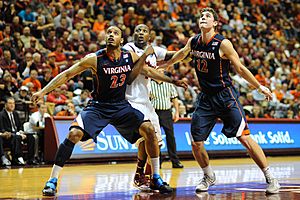
Since there are no major professional teams, college sports are very popular. A 2015 poll showed that 34% of Virginians liked the Virginia Cavaliers. And 28% liked their rivals, the Virginia Tech Hokies. The men's and women's college basketball teams from the Cavaliers, VCU Rams, and Old Dominion Monarchs have won many championships. The Hokies football team went to a bowl game for 27 years in a row.
Fourteen universities in Virginia compete in NCAA Division I. Three historically Black schools compete in Division II. The NCAA holds some of its Division III championships in Salem.
High School Sports
Virginia has some of the best high school basketball programs in the country. These include Paul VI Catholic High School and Oak Hill Academy. In the 2018–2019 school year, over 174,000 high school students played sports. The most popular sports were football, track, and soccer. Youth soccer leagues are also very popular.
Learning in Virginia: Education
Virginia's education system is often ranked among the top five states. Virginia students do better than average in all subjects. All schools must follow standards set by the Virginia Department of Education. These are called the Standards of Learning.
Public K–12 schools in Virginia are run by counties and cities. In the 2018–19 school year, 1,290,576 students were in 2,293 schools. This includes eight charter schools. There are also Governor's Schools for gifted students. The Virginia Council for Private Education oversees 483 private schools. About 17,283 students are homeschooled.
In 2019, 91.5% of high school students graduated on time. This was an increase from 2013. Virginia has one of the smallest racial gaps in graduation rates. Even though school segregation ended in the 1960s, some schools are still very separated by race. However, non-white school districts in Virginia often get slightly more money per student.
Colleges and Universities in Virginia
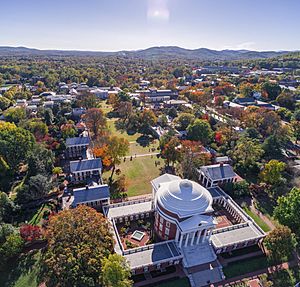
In 2019, 38.2% of Virginians had a bachelor's degree or higher. This was the sixth highest in the U.S. As of that year, Virginia has 169 colleges and universities. In 2021, U.S. News & World Report ranked the University of Virginia 4th among public universities. The College of William and Mary was 11th. Virginia Tech was 29th.
There are 124 private colleges in Virginia. These include Washington and Lee University and the University of Richmond. Virginia Tech and Virginia State University are the state's land-grant universities. Virginia State is also one of five historically black colleges and universities in Virginia. The Virginia Military Institute is the oldest state military college. Virginia also has 23 community colleges with 40 campuses. In 2021, community college became free for most low- and middle-income students.
Images for kids
-
Richmond was the capital of the Confederacy from 1861 to 1865, when it was partially burned by them prior to its recapture by Union forces.
-
Protests in 2020 were focused on the Confederate monuments in the state.
-
Great Falls is on the fall line of the Potomac River, and its rocks date to the late Precambrian.
-
Oak trees in particular produce a haze of isoprene, which helps gives the Blue Ridge Mountains their signature color.
-
White-tailed deer are also known as Virginia deer, and up to seven thousand live in Shenandoah National Park.
-
Americana Roots Folk Rock band The Steel Wheels play at the Jefferson Theater in Charlottesville
-
USA Today, the nation's most circulated newspaper, has its headquarters in McLean.
See also
 In Spanish: Virginia para niños
In Spanish: Virginia para niños




